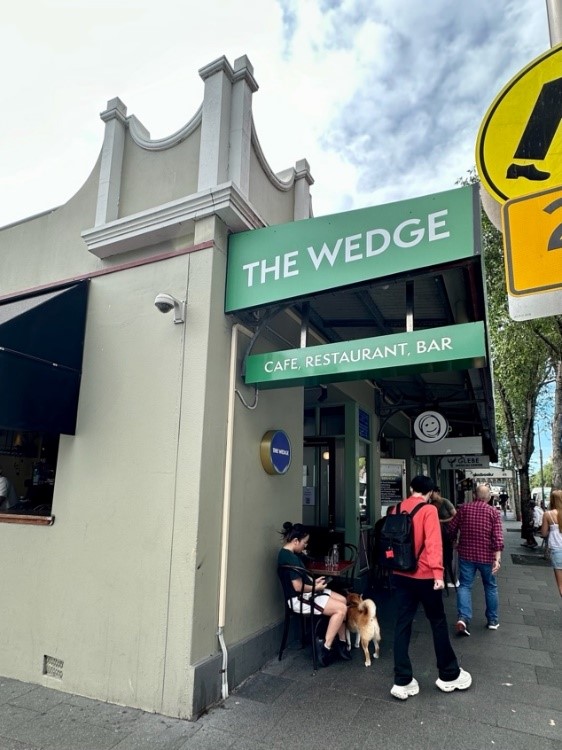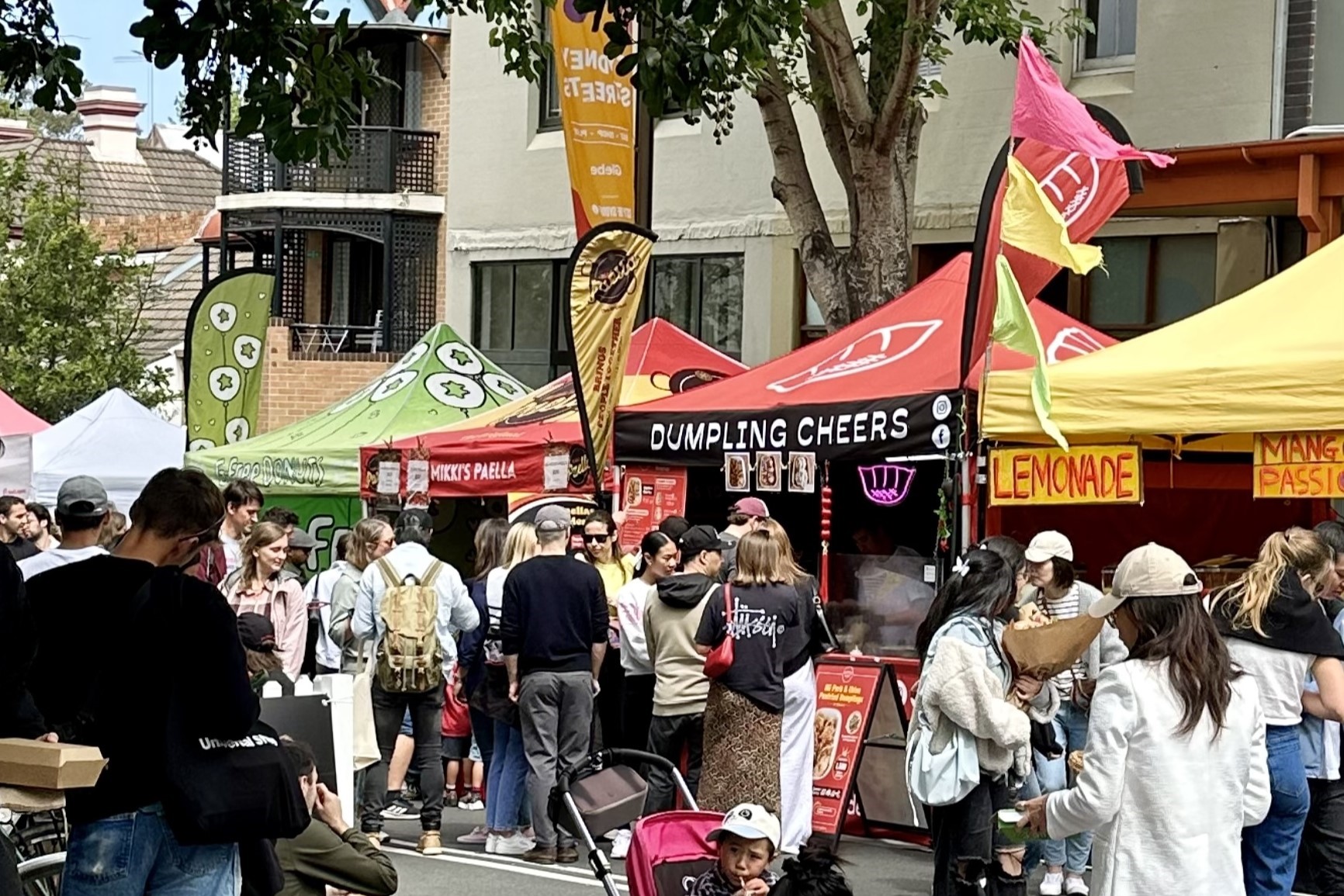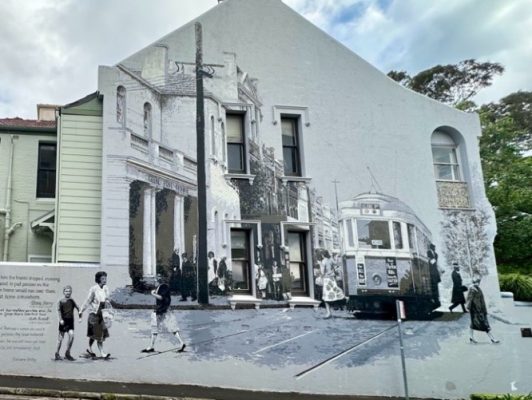By Brian Fuller, Bulletin 2024/9, November
In the June edition of the Bulletin (Issue 4/2024), Beryl Hesketh’s letter to the Editor praised small shopkeepers along Glebe Point Road (and other streets) for their contribution to our community. She correctly pointed out that the good relationships between shopkeepers and their customers contribute to better social interaction. Beryl was right to call on us to support our local businesses when we can.
That support can come in many ways, the most obvious being buying goods and services from them, and as we come to know them, perhaps understand the challenges that they face. Those challenges would include competition from online retailing, social media, large shopping centres competing nearby, and home delivery from the big supermarkets and takeaway food outlets. I’m sure we’ve all noticed the high incidence of supermarket delivery vans in our streets, and even more noticeable, the countless number of scooters and the like delivering takeaway food, night after night. These new retailing models mean fewer reasons to visit the Main Street.
This situation is not unique to Glebe Point Road. Main Streets around the developed world have realised they will need to reposition themselves if they are to remain relevant to their local communities.

This article looks at two local success stories, the things we can do ‘tomorrow,’ and how the emerging trend of non-profit organisations advocating for a return of our streets as ‘places for people’. The article also looks at a proposed new infrastructure which, if done well, offers a significant opportunity for Glebe Point Road, our shopkeepers and therefore the community at large.
Celebrating their success
It is rare that the press features a story about our successful retailers. SBS recently published an article about Galluzzo’s Fruit and Veg store at 187 Glebe Point Road. The store opened in 1934 and has been in the same family for 90 years. That is a remarkable achievement for any store on any Main Street. Navigating the economic and social highs and lows during such a long period requires tenacity, hard work and a savvy talent for running a small business.
After 90 years, the family has decided to sell the business. Fortunately, it has been sold to two brothers with the same Italian pedigree, who will continue to trade as Galluzzo’s Fruiterers by Dan and Josh.

Time Out recently published its list of the 69 best cafes in Sydney. Coming in at number 15 on that list is The Wedge at 53-55 Glebe Point Road, on the corner of Mitchell Street and opposite the Glebe Primary School. Of all the cafés in Sydney and the metropolitan area, to be included in the top 69 is another outstanding achievement by one of our Main Street retailers.
Renowned for its boundary-pushing menu, friendly staff, and great service, The Wedge has become the go-to café for many locals. Having traded for seven years, it has become an integral member of the Glebe community.
There are, of course, other successful stores along our Main Street, but I wanted to highlight the two most recent examples of recognition in the press.
Social media
Those of us who use social media can ‘follow’ our Main Street businesses. It’s a great way to give feedback that encourages them and, from time to time, remind them of the direction that their customers would prefer they take. ‘Liking’ a post effectively gives a great review, encouraging others to visit the store.
Community Fair – Sydney Streets
The City of Sydney has been hosting community fairs in the villages’ Main Streets twice yearly. The most recent for Glebe Point Road was held on Saturday, 12 October and was arguably the most successful yet. It was a fun community day full of free entertainment, great food and a community vibe. It’s a great way to showcase our Main Street at its best, but it can only be successful when the community gets behind it.


Advocacy on behalf of our shopkeepers
Given the large crowd that attended a Town Hall community meeting on 3 February 2023, it’s clear that many are concerned about our Main Street’s future direction. The meeting was hosted by ‘Save our High Streets’, and the community packed into the ground floor meeting room. It appeared that the high number of attendees took the hosts by surprise.
One of the most effective ways to influence Government and Council decisions that affect local shopkeepers and businesses is via advocacy. To do this, we need to be aware of discussions, action groups and proposed policy changes that may affect our Main Street. There is now a significant narrative, locally and globally, about the future direction of Main Streets, their contribution to their communities and the amenity of the public domain. That narrative generally commences with something along the lines of ‘Are Main Streets for people or cars?’
Outdoor dining
You may be aware that the City of Sydney allows cafes, bars, restaurants and hotels to provide outdoor dining in parking bays by granting them a licence. Those licences are temporary, generally for 12 to 18 months. The existing licences expire on 31 December. Council is considering extending them for six months, until 30 June 2025. That extension is to coincide with the expiration of the ‘fee waiver’ period.
There are various levels of presentation of outdoor dining set-ups, but common to most is the road barrier (which looks as if it were extracted from a Grand Prix circuit), basic table and seating that generally has no relationship to the local character of the place, and a kerb that is a potential trip hazard for patrons returning onto the permanent pavement. There is little or no ‘greening’ of the space. Under the current temporary licence arrangements, the operators cannot confidently invest in safe and presentable furniture, offer longer term employment prospects to local people or undertake marketing strategies. Infrastructure and amenity that are temporary are rarely optimised to full potential, resulting in lost opportunities. Investment by all stakeholders in temporary arrangements is inefficient, unsustainable and, in the end, costly.
Committee for Sydney
The Committee for Sydney is Greater Sydney’s urban policy think tank. Their goal is to help Greater Sydney be the best it can be, for all. In their 2020 discussion paper Reclaiming Sydney’ High Streets, the Committee writes:
Most of the high streets in Sydney were built before the widespread uptake of the motor car. These pre-war streets are designed to be pedestrian friendly. Before cars were around, they had to be. …The high street was the product of thousands of years of city-building: an urban pattern based on access by proximity rather than access by mobility …We continue to believe that the essential function of a high street is social: people are still going to want to congregate to be with each other, to strut and sit, to eat and drink – and most likely to buy some things too. (p. 27)


Better Streets
Better Streets describes itself as:
Australia’s peak body for safer, healthier and more sustainable streets. They believe Australia deserves safe, healthy, accessible, profitable and enjoyable climate-friendly streets that are welcoming for people and better for the environment. Better Streets knows exactly how to improve the streets you care about.
Better Streets Australia has five key objectives:
- Get kids active
- Slow vehicles down
- Boost local businesses
- Make more crossings
- Provide transport choices
Both Lord Mayor Clover Moore and Councillor Sylvie Ellsmore have confirmed their support for Better Streets, although Council’s priority focus seems to be on the fifth objective (providing transport choices) and, to a lesser extent, on supporting local businesses with its Sydney Streets Fair day and temporary outdoor dining.
Better Streets has a long way to go, and the nuances of each street will determine which of the five objectives needs greater focus.
Broadway light rail: implications for Glebe Point Road
For years, numerous State Governments have struggled with a Parramatta Road solution, but over the last 12 to 18 months, there has been growing discussion about light rail from Central Station along Parramatta Road to Broadway and beyond.
During the last Council election campaign, the Lord Mayor announced that, if re-elected, Council would work to extend light rail along Parramatta Road and Broadway to Green Square. At their 29 July meeting, Council resolved to support the Parramatta Road to Green Square Light Rail, citing the success of the George Street light rail and the State Government’s proposed Tech Central innovation precinct at Camperdown as stimuli for the project. Council approved investing $100 million in public domain infrastructure between Green Square and the University of Sydney, and to work with the State Government and its light rail provider, ALTRAC, to bring the proposal to fruition. While the NSW Government is yet to formally commit to the proposal, ALTRAC is promoting its credentials to deliver.
 |
|
Artist’s impression of how Broadway could look when transformed into a green gateway. (Photo source: City of Sydney News: New plan advances the City of Sydney’s transport vision) |
The image above does not indicate lanes for cars, but all parties have indicated there will be some provision for vehicular traffic (even if one lane only each way). Regardless of whether the light rail replaces all the existing buses, there is no doubt that Broadway’s current eight to nine vehicle lanes will need to reduce in number to accommodate the light rail, cycle lanes, widened footpaths, and landscaping.
Conceptually, a new light rail along Broadway and Parramatta Road is a major win for more public transport and a huge contributor to net zero emissions. It has the potential to be a great Boulevard. But what does it mean for Glebe Point Road? Is it a threat or an opportunity? It would be a huge traffic, planning and design catastrophe if an imaginary line were to be drawn across the intersection of Glebe Point Road with Broadway. The $100 million investment in the public domain infrastructure must include the integration of Broadway with Glebe Point Road so that each is complementary to the other. It would be a community loss if the existing shops, cafes, restaurants and small businesses were to relocate to a redesigned and revitalised Broadway.
Light rail on Broadway and Parramatta Road could be a great opportunity, provided there was genuine and effective community consultation and a balanced traffic analysis, planning and design process.
Have your say
A common thread is emerging among government agencies, councils and not-for-profit groups: the recognition that Main Streets must return to being public places for people. Communities need to socialise, not only in recreational parks but also in the Main Street as they go about their shopping, dining and accessing essential services. To do that, Main Streets must have successful shops and businesses that meet the needs of the broader local community. Today that includes outdoor places for a coffee or a meal in a safe and healthy environment.
The push to net zero emissions runs in parallel with the need for better streets, particularly Main Streets. To ensure that the local character and social fabric are preserved, it is essential that Government and Councils are guided by community feedback as they seek to deliver revitalised Main Streets for people. Not-for-profit groups need membership or mailing lists to promote their objectives.
The City of Sydney continually seeks community comment with its Have Your Say initiative. To have your say, you first need to register with Council. You can write to Councillors at any time and express your ideas. The more feedback, the better the outcome.








2 comments. Please add yours.
Alfresco dining has become a welcome feature of Sydney life, however too frequently the concept of dining has been jettisoned in favour of drinking.
Some licensed businesses, by leaving doors and windows open, have integrated the outside street areas into the ordinary operations of the pub or café, and while this may be barely tolerable in entertainment precincts it causes a severe reduction of the amenity of life in residential areas.
There must be a clear demarcation between what behaviour is allowed in an “entertainment zone” and what is permitted in residential streets, together with the means, and the will, to control any spillover effect.
Council guidelines already differentiate between extended operating hours permitted in entertainment precincts and core hours for residential areas. Sadly in some instances Council has allowed extended hours in residential areas on the grounds: “the benefits of outdoor dining at night encompass heightened activation of public spaces and bolsters support for local businesses within the community.” But does that make sense when the business in question is the only hospitality business within 200 or 300 metres? In these cases, the 8pm curfew should be strictly enforced.
Why? How many more cafes does Glebe need? Many of them are struggling because there are too many cafes and not enough other businesses. Remember when we had hardware shops, butcher shops, clothing shops, second hand shops. Reasons to shop along the strip. Reasons to come to Glebe. You don’t mention alcohol. Almost all of the cafes in Glebe have liquor licences, making the area unsafe, unpleasant and noisy for residents.
There are many people who live along Glebe Point Road and nearby. Some of them drive cars. Why should their amenity take second place to the 40 or so licenced premises along Glebe Point Road. Especially when the Liquor & Gaming Authority figures for the number of licenced premises in Glebe show liquor licences have been reducing as businesses hit the wall. If you walk along Glebe Point road you can see the number of closed businesses.
Its time to wake up and push back against the campaign to turn Glebe into one big pub. Glebe Point Road is not George Street or Kings Cross. Consider what makes Glebe different and be careful what you wish for.
By the way, its not that hard to make a coffee.